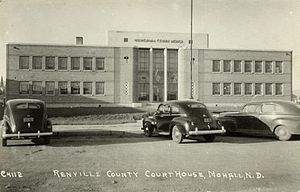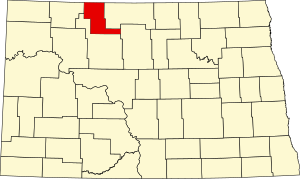Renville County, North Dakota
Renville County | |
|---|---|
 Renville County Courthouse. Photographed in 1940. | |
 Location within the U.S. state of North Dakota | |
 North Dakota's location within the U.S. | |
| Coordinates: 48°43′N 101°40′W / 48.71°N 101.66°W | |
| Country | |
| State | |
| Founded | January 4, 1873 (created) July 20, 1910 (organized) |
| Named for | Joseph Renville |
| Seat | Mohall |
| Largest city | Mohall |
| Area | |
| • Total | 893 sq mi (2,310 km2) |
| • Land | 877 sq mi (2,270 km2) |
| • Water | 16 sq mi (40 km2) 1.8% |
| Population (2020) | |
| • Total | 2,282 |
| • Estimate (2022) | 2,220 |
| • Density | 2.6/sq mi (0.99/km2) |
| Time zone | UTC−6 (Central) |
| • Summer (DST) | UTC−5 (CDT) |
| Congressional district | At-large |
| Website | www |
Renville County is a county in the U.S. state of North Dakota. As of the 2020 census, the population was 2,282.[1] Its county seat is Mohall.[2]
Renville County is part of the Minot, ND Micropolitan Statistical Area. It is located south of the Canada–United States border with Saskatchewan.
History
[edit]The Dakota Territory legislature created the county on January 4, 1873. It was named for Joseph Renville, an influential fur trader, interpreter, translator, and important figure in dealings between white men and the Sioux. The county was not organized at that time, nor was it attached to another county for administrative or judicial purposes. The proposed county boundaries were altered in 1883, in 1885, and 1887, and on November 8, 1892, the county was dissolved and absorbed into Bottineau and Ward counties due to a lack of settlement.
The general election held November 3, 1908 included a question asking whether a portion of Ward County should be partitioned off and named Renville County (covering a different area than the original county). This question reportedly failed to pass, but it was promptly contested in court, resulting in a ruling by the state Supreme Court ruled on June 3, 1910, that the split should be carried out.[3] The state governor proclaimed the result in a July 12 proclamation, and the county government was organized on July 20 of that year,[4] with Mohall as the county seat.[4][5]

Geography
[edit]Renville County lies on the north line of North Dakota; its north boundary line abuts the south boundary line of Canada. The Souris River flows southeasterly through the county on its way to Hudson Bay. The county terrain consists of rolling hills, largely devoted to agriculture.[6] The terrain slopes to the south and east; its highest point is its SW corner, at 2,005 ft (611 m) ASL.[7] The county has a total area of 893 square miles (2,310 km2), of which 877 square miles (2,270 km2) is land and 16 square miles (41 km2) (1.8%) is water.[8]
Major highways
[edit]Adjacent counties and rural municipalities
[edit]- Mount Pleasant No. 2, Saskatchewan - northwest
- Argyle No. 1, Saskatchewan - northeast
- Bottineau County - east
- McHenry County - southeast
- Ward County - south
- Burke County - west
- Upper Souris National Wildlife Refuge (part)
- Upper Souris Wildlife Refuge
- Lake Darling (part)
Demographics
[edit]| Census | Pop. | Note | %± |
|---|---|---|---|
| 1910 | 7,840 | — | |
| 1920 | 7,776 | −0.8% | |
| 1930 | 7,263 | −6.6% | |
| 1940 | 5,533 | −23.8% | |
| 1950 | 5,405 | −2.3% | |
| 1960 | 4,698 | −13.1% | |
| 1970 | 3,828 | −18.5% | |
| 1980 | 3,608 | −5.7% | |
| 1990 | 3,160 | −12.4% | |
| 2000 | 2,610 | −17.4% | |
| 2010 | 2,470 | −5.4% | |
| 2020 | 2,282 | −7.6% | |
| 2022 (est.) | 2,220 | [9] | −2.7% |
| U.S. Decennial Census[10] 1790-1960[11] 1900-1990[12] 1990-2000[13] 2010-2020[1] | |||
2020 census
[edit]As of the census of 2020, there were 2,282 people.
2010 census
[edit]As of the census of 2010, there were 2,470 people, 1,061 households, and 685 families in the county. The population density was 2.82 people per square mile (1.09 people/km2). There were 1,386 housing units at an average density of 1.58 units per square mile (0.61/km2). The racial makeup of the county was 97.9% white, 0.4% American Indian, 0.2% Asian, 0.1% black or African American, 0.2% from other races, and 1.2% from two or more races. Those of Hispanic or Latino origin made up 1.0% of the population. In terms of ancestry, 39.5% were German, 39.1% were Norwegian, 11.6% were Irish, 9.7% were English, 9.5% were Swedish, and 2.3% were American.
Of the 1,061 households, 25.8% had children under the age of 18 living with them, 56.7% were married couples living together, 5.1% had a female householder with no husband present, 35.4% were non-families, and 30.9% of all households were made up of individuals. The average household size was 2.28 and the average family size was 2.85. The median age was 45.4 years.
The median income for a household in the county was $49,583 and the median income for a family was $63,068. Males had a median income of $39,950 versus $25,469 for females. The per capita income for the county was $26,856. About 3.8% of families and 5.9% of the population were below the poverty line, including 5.9% of those under age 18 and 9.6% of those age 65 or over.
Population by decade
[edit]
Communities
[edit]Cities
[edit]Townships
[edit]- Brandon
- Callahan
- Clay
- Colquhoun
- Eden Valley
- Ensign
- Fairbanks
- Grassland
- Grover
- Hamerly
- Hamlet
- Hurley
- Ivanhoe
- Lockwood
- McKinney
- Muskego
- Plain
- Prescott
- Prosperity
- Rockford
- Roosevelt
- Stafford
- Van Buren
- White Ash
Politics
[edit]Renville County voters have voted Republican in every national election since 1976 (as of 2020).
| Year | Republican | Democratic | Third party(ies) | |||
|---|---|---|---|---|---|---|
| No. | % | No. | % | No. | % | |
| 2020 | 1,065 | 80.74% | 220 | 16.68% | 34 | 2.58% |
| 2016 | 993 | 76.80% | 201 | 15.55% | 99 | 7.66% |
| 2012 | 851 | 66.59% | 398 | 31.14% | 29 | 2.27% |
| 2008 | 799 | 59.36% | 505 | 37.52% | 42 | 3.12% |
| 2004 | 953 | 64.87% | 497 | 33.83% | 19 | 1.29% |
| 2000 | 820 | 61.56% | 443 | 33.26% | 69 | 5.18% |
| 1996 | 576 | 42.54% | 562 | 41.51% | 216 | 15.95% |
| 1992 | 655 | 39.22% | 580 | 34.73% | 435 | 26.05% |
| 1988 | 893 | 51.03% | 837 | 47.83% | 20 | 1.14% |
| 1984 | 1,163 | 65.56% | 592 | 33.37% | 19 | 1.07% |
| 1980 | 1,154 | 62.65% | 570 | 30.94% | 118 | 6.41% |
| 1976 | 812 | 43.99% | 1,008 | 54.60% | 26 | 1.41% |
| 1972 | 1,121 | 61.09% | 702 | 38.26% | 12 | 0.65% |
| 1968 | 851 | 46.86% | 880 | 48.46% | 85 | 4.68% |
| 1964 | 640 | 32.05% | 1,356 | 67.90% | 1 | 0.05% |
| 1960 | 1,012 | 45.38% | 1,217 | 54.57% | 1 | 0.04% |
| 1956 | 1,035 | 50.22% | 1,025 | 49.73% | 1 | 0.05% |
| 1952 | 1,571 | 66.57% | 767 | 32.50% | 22 | 0.93% |
| 1948 | 812 | 46.61% | 838 | 48.11% | 92 | 5.28% |
| 1944 | 1,046 | 48.34% | 1,095 | 50.60% | 23 | 1.06% |
| 1940 | 1,202 | 47.03% | 1,298 | 50.78% | 56 | 2.19% |
| 1936 | 611 | 21.36% | 1,766 | 61.73% | 484 | 16.92% |
| 1932 | 689 | 25.23% | 1,969 | 72.10% | 73 | 2.67% |
| 1928 | 1,473 | 55.09% | 1,174 | 43.90% | 27 | 1.01% |
| 1924 | 649 | 32.18% | 120 | 5.95% | 1,248 | 61.87% |
| 1920 | 1,987 | 73.65% | 581 | 21.53% | 130 | 4.82% |
| 1916 | 532 | 31.54% | 1,012 | 59.99% | 143 | 8.48% |
| 1912 | 224 | 17.58% | 420 | 32.97% | 630 | 49.45% |
See also
[edit]References
[edit]- ^ a b "State & County QuickFacts". United States Census Bureau. Retrieved April 6, 2023.
- ^ "Find a County". National Association of Counties. Retrieved June 7, 2011.
- ^ Fitzmaurice v. Willis, 127 N.W. 95 (N.D. 1910).
- ^ a b "Dakota Territory, South Dakota, and North Dakota: Individual County Chronologies". Dakota Territory Atlas of Historical County Boundaries. The Newberry Library. 2006. Archived from the original on April 2, 2018. Retrieved February 4, 2015.
- ^ "County History". Official Portal for North Dakota State Government. Archived from the original on February 2, 2015. Retrieved May 4, 2011.
- ^ a b c d "Renville County · North Dakota". Google Maps. Retrieved April 27, 2024.
- ^ ""Find an Altitude/Renville County ND" Google Maps (accessed February 25, 2019)". Archived from the original on May 21, 2019. Retrieved February 25, 2019.
- ^ "2010 Census Gazetteer Files". United States Census Bureau. August 22, 2012. Archived from the original on January 29, 2015. Retrieved February 1, 2015.
- ^ "Annual Estimates of the Resident Population for Counties: April 1, 2020 to July 1, 2022". Retrieved April 6, 2023.
- ^ "United States Decennial Census". United States Census Bureau. Retrieved February 1, 2015.
- ^ "Historical Census Browser". University of Virginia Library. Retrieved February 1, 2015.
- ^ Forstall, Richard L., ed. (April 20, 1995). "Population of Counties by Decennial Census: 1900 to 1990". United States Census Bureau. Retrieved February 1, 2015.
- ^ "Census 2000 PHC-T-4. Ranking Tables for Counties: 1990 and 2000" (PDF). United States Census Bureau. April 2, 2001. Archived (PDF) from the original on March 27, 2010. Retrieved February 1, 2015.
- ^ Greene, shown on a 1977 USGS map (at present day 46th Ave NW and 86th Street NW), was a station stop on the Minneapolis, St. Paul and Sault Ste. Marie Railroad. Its former streets are still shown on Google Earth and Yahoo! Maps
- ^ "Greene, N. Dak". www.thomasgloger.com. Archived from the original on March 4, 2016. Retrieved April 13, 2018.
- ^ Leip, David. "Atlas of US Presidential Elections". uselectionatlas.org. Retrieved April 13, 2018.
- ^ The leading "other" candidate, Progressive Theodore Roosevelt, received 341 votes, while Socialist Eugene Debs received 224 votes, Prohibition candidate Eugene Chafin received 17 votes.
External links
[edit]- Renville County official website
- Renville County North Dakota History website
- Renville County maps, Sheet 1 (northern) and Sheet 2 (southern), North Dakota DOT


